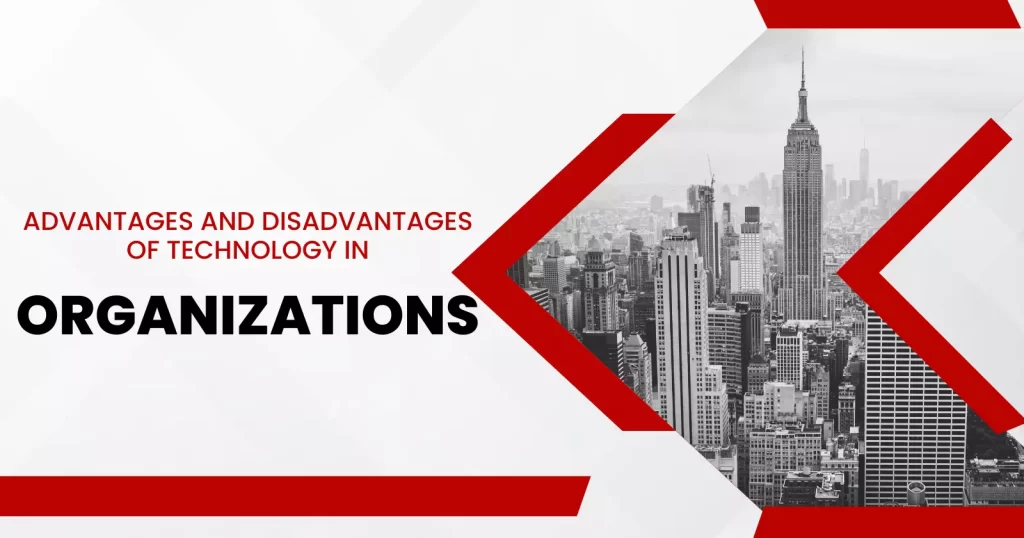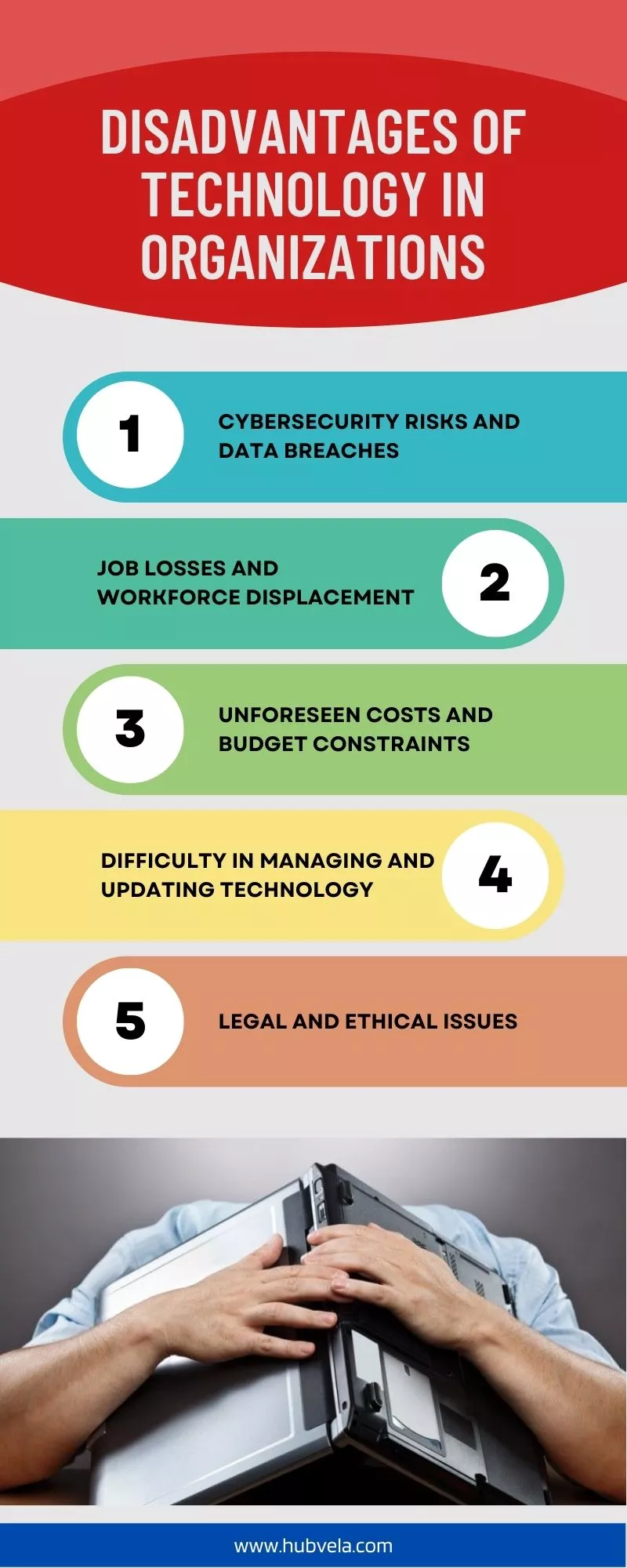Technology has revolutionized the way organizations operate, from communication to production and everything in between.
With the rise of digital tools and platforms, businesses have access to a wealth of resources that can streamline processes, increase efficiency, and improve overall performance.
However, as with any tool, technology also has its drawbacks. In this article, we will explore the advantages and disadvantages of technology in organizations.

--Advertisement--
Advantages of Technology in Organizations
In today’s fast-paced world, technology has become an integral part of every organization. From streamlining processes to managing contacts and employee records, technology has revolutionized the way businesses operate.
We will explore the advantages of technology in organizations.

1. Increased Efficiency and Productivity
The advantages of technology in organizations are numerous, and one of the most significant is the increased efficiency and productivity it brings.
With the help of technology, companies can streamline their processes, automate repetitive tasks, and reduce the time and effort required to complete them.
For instance, virtualization technology can help reduce the number of servers, which in turn reduces the time and effort required to maintain them.
Additionally, technology allows employees to work from home, which can increase their productivity and work-life balance.
Technology also ushers in efficiency and productivity in many ways, such as accounting, billing, payroll, and asset management.
Higher productivity increases wages, which has an enormous impact on the standard of living.
Efficient utilization of inputs signifies that fewer inputs are required to produce a certain level of output, which is an advantage in increasing productivity and efficiency of labor.
2. Enhanced Data Management and Analysis
Enhanced data management and analysis is one of the most significant advantages of technology in organizations.
With the help of data management systems, companies can collect, process, and store data in a secure and organized manner.
This data can then be analyzed to gain insights into customer behavior, market trends, and business operations.
By utilizing data management technologies, organizations can achieve improved organizational consistency, increased productivity, greater collaboration and communication, and faster, more knowledgeable business decisions.
With reliable, up-to-date data, companies can respond more efficiently to market changes and customer needs, which can ultimately lead to increased revenue and profits.
In today’s data-driven world, effective data management and analysis are critical for organizations to gain a competitive advantage.
3. Better Customer Experience
Technology has revolutionized the way organizations interact with their customers, leading to better customer experiences.
With the ability to capture, analyze, and utilize personalized customer data at scale, companies can understand their customers’ needs and preferences better than ever before.
By monitoring and enhancing different touchpoints along the customer journey, companies can consistently bring more value to users, resulting in deeper loyalty and higher levels of engagement.
Personalizing the digital customer experience is a current trend that is helping businesses to enhance and personalize their customer experience.
In exemplary service organizations, executives understand that they need to put customers and frontline workers at the center of their strategy to create a better customer experience.
Therefore, technology is a crucial tool for organizations to improve their customer experience and gain a competitive advantage.
4. Remote Work and Telecommuting Opportunities
Technology has revolutionized the way organizations operate, and remote work is one of the most significant advantages it has brought.
Remote work and telecommuting opportunities have become increasingly popular, especially in the wake of the COVID-19 pandemic.
The benefits of remote work are numerous, including increased productivity, better performance, and cost savings for both employees and employers.
Remote work has also opened up new opportunities for hiring and expanding the pool of potential employees.
Moreover, remote work has enabled organizations to tap into a global talent pool, allowing them to hire the best talent from anywhere in the world.
This has led to a more diverse and inclusive workforce, which has been shown to improve creativity and innovation.
Additionally, remote work has been found to reduce stress and improve work-life balance, leading to happier and more satisfied employees.
In conclusion, remote work and telecommuting opportunities are a significant advantage of technology in organizations.
They offer numerous benefits, including increased productivity, better performance, cost savings, and a more diverse and inclusive workforce.
As technology continues to evolve, remote work is likely to become even more prevalent, and organizations that embrace it will be better positioned to succeed in the future.
5. Better Decision Making and Planning
With the help of technology, organizations can improve their decision-making process, making it faster, more streamlined, and less prone to error.
Technology as a business strategy allows organizations to plan for key rollouts that improve the experience for both employees and customers, leading to better planning and decision-making.
Technology planning is a process that takes time and resources to understand what is appropriate for staff and the organization, leading to better planning and decision-making.
By using technology, organizations can make informed decisions that will positively impact the company, and it can be integrated with existing business processes.
Data-driven decision-making, which is made possible by technology, brings many benefits to businesses that embrace it, leading to better planning and decision-making.
Therefore, the use of technology in organizations can significantly improve decision-making and planning, leading to better outcomes and increased success.
Disadvantages of Technology in Organizations
Technology has revolutionized the way organizations operate, making tasks easier, faster, and more efficient.
However, it is not without its drawbacks. As with any tool, technology has its disadvantages, and organizations must be aware of them to make informed decisions about its use.
We will explore some of the disadvantages of technology in organizations and how they can impact business operations.

1. Cybersecurity Risks and Data Breaches
The disadvantages of technology in organizations cannot be overlooked, especially when it comes to cybersecurity risks and data breaches.
With the rise of connected devices and the Internet of things, organizations are becoming more vulnerable to cyber-attacks.
Data breaches can have significant and long-lasting consequences for both the company and the individuals whose data is stolen.
It is crucial for organizations to identify and understand the cybersecurity risks to their systems, people, assets, data, and capabilities, and implement appropriate security controls and measures to protect their critical assets against cyber threats.
The costs of a data breach can be enormous, including identifying the breach, notifying affected parties, downtime, recovery, repairs, lawsuits, and customer losses.
Therefore, organizations must prioritize cybersecurity and take proactive measures to prevent data breaches and protect sensitive information.
2. Job Losses and Workforce Displacement
One of the major drawbacks is the loss of jobs and workforce displacement. The COVID-19 pandemic has shown how technology can lead to head-spinning job losses, with 22 million jobs lost within two months.
The transition to clean energy is also affecting workers and communities, with energy jobs changing. A study has shown that robots create a stronger displacement effect, leading to job loss.
Job displacement is generally understood as a form of job loss that stems from shifting economic and business conditions.
While some jobs will see less automation, others will be more vulnerable to displacement.
It is important for organizations to consider the impact of technology on their workforce and take steps to mitigate the negative effects.
This can include retraining programs, job sharing, and other measures to support workers who are displaced by technology.
3. Unforeseen Costs and Budget Constraints
While technology can improve efficiency and productivity, it can also be expensive to implement and maintain.
Organizations must carefully consider the costs of technology and ensure that it fits within their budget constraints.
Failure to do so can result in financial strain and even project failure. To manage costs, organizations can look at past projects and stick closely to their proposed budget while remaining open to changes that may affect costs.
It is important to identify and overcome resource constraints in project management to ensure that technology is implemented effectively and efficiently.
4. Difficulty in Managing and Updating Technology
With the constant advancements in technology, it can be challenging for organizations to keep up with the latest trends and ensure that their systems are up-to-date.
This can lead to technology misuse, breakage, and even system failures.
Additionally, managing innovation in technology can be difficult, as disruptive changes can quickly become too big to control.
While technology can bring benefits such as increased efficiency and productivity, it is important for organizations to have a plan in place for managing and updating their technology to avoid potential issues and ensure that they are getting the most out of their investments.
5. Legal and Ethical Issues
One of the major concerns is the legal and ethical issues that arise from the use of technology.
Ethical considerations in the use of technology are important, especially in international business where cultural differences may affect the interpretation of ethical standards.
Business owners and HR professionals may face ethical dilemmas such as conflicts of interest, discrimination, and privacy concerns.
It is important for organizations to have a framework for ethical decision-making to guide employees in making ethical choices.
Legal issues such as data privacy, intellectual property rights, and cybersecurity are also major concerns in the use of technology in organizations.
Organizations need to ensure that they comply with legal requirements and regulations to avoid legal liabilities.
It is important for organizations to strike a balance between the advantages and disadvantages of technology and to ensure that they use technology in an ethical and legal manner.
Conclusion on the Advantages and Disadvantages of Technology in Organizations
In conclusion, technology has both advantages and disadvantages in organizations.
On the one hand, it can increase efficiency, productivity, and communication.
On the other hand, it can lead to job loss, security breaches, and over-reliance on machines.
It is important for organizations to carefully consider the implementation of technology and weigh the potential benefits against the risks.
Additionally, it is crucial to provide proper training and support to employees to ensure they can effectively use the technology.
Ultimately, technology should be viewed as a tool to enhance organizational performance, rather than a replacement for human skills and expertise.


